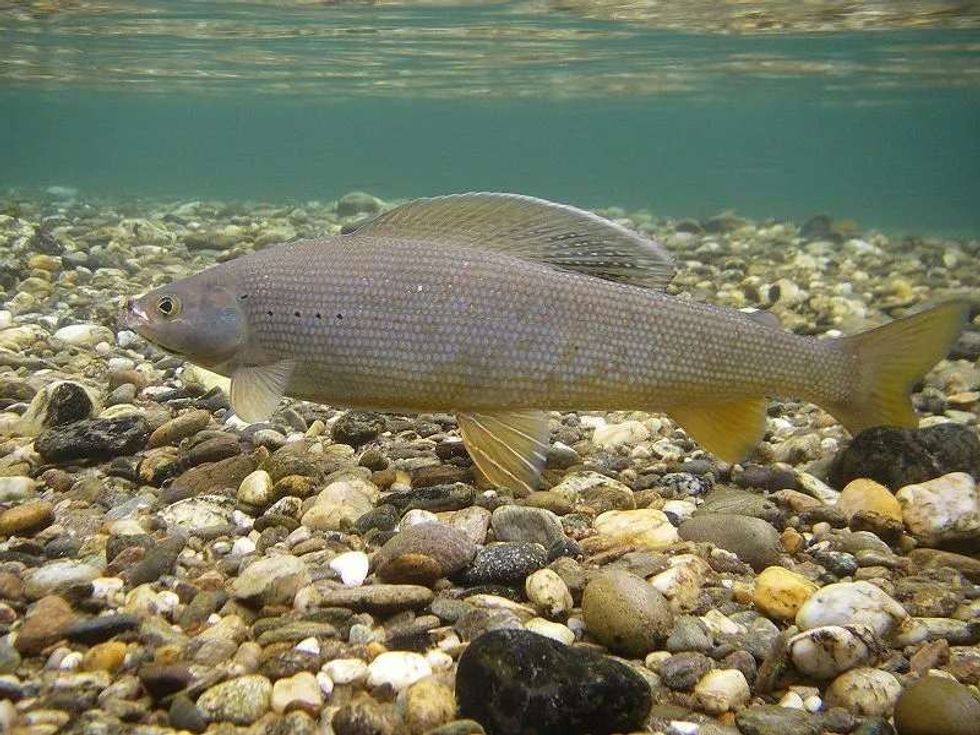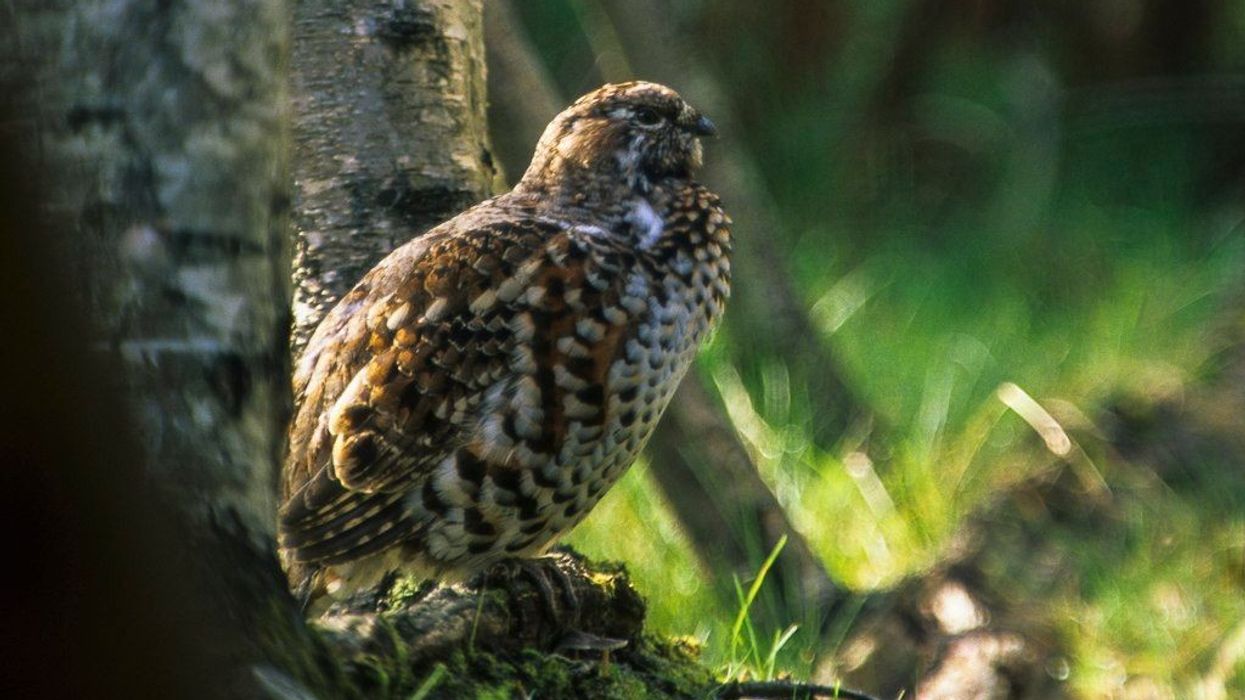Do you want to learn some interesting Arctic grayling facts? Then keep reading.
The Arctic grayling, Thymallus arcticus, is a beautiful freshwater fish species native to North America. Previously their populations were dominant in the Arctic drainages from Hudson Bay to Alaska, the Pacific drainages, Montana, and upper Missouri River drainage.
Though their Michigan population has gone almost extinct, they are still found in the Missouri and Montana regions. The Arctic grayling prefers freshwater habitats and is often seen in cold, clear rivers, streams, and lakes with tributaries.
The fishes are not communal in nature and do not get along with other fishes, except for a few related species. The colorful Arctic grayling is about 9.9-15.7 in (25-40 cm) in length and they range in weight somewhere between 8.8-35.3 oz (0.24-1 kg).
The fish has red fringed dorsal fin rays with colored dots or markings.
The dorsal fin rays also resemble large sails. The side of the body is black, golden, or silver, the belly is white and their whole body is covered in beautiful colored markings.
The Arctic graylings mate in late spring or early summer by laying eggs, between the ages of five and seven. The fishes do not live for many years and reach the reproductive stage by the age of three.
These water animals live by feeding on aquatic insects and crustaceans. Although they have disappeared from many of their original habitats, they have a current stable population.
Read on to find more Arctic grayling fish facts, and if you like this article, make sure to check out neon goby and carp.
Grayling Interesting Facts
What type of animal is a Grayling?
The grayling or Arctic grayling is a fish of the Salmonidae family.
What class of animal does a Grayling belong to?
The Arctic grayling belongs to the class Actinopterygii of the animal kingdom.
How many Graylings are there in the world?
There is not enough information to ascertain the exact population of the Arctic grayling fish species currently living on this planet. However, we do know that there are quite a few of these fishes living in the freshwaters of North America, and their current population is not facing any serious risk or threat.
Where does a Grayling live?
The Arctic grayling species are the only graylings to be found in the northern part of America. Besides that, their Michigan populations went extinct due to largescale human activities and interference in their habitat, while both their lake-dwelling and river-dwelling populations in Montana still exist.
Their once widespread population throughout the Missouri River drainage system has been reduced to a small population in southwest Montana's Big Hole River.
What is a Grayling's habitat?
The Arctic grayling, Thymallus arcticus, is often spotted in clear and cold, small streams, rivers, and lakes with tributaries. These fishes can be found in eddies and pools and below riffles in rivers. The Arctic grayling is typically a beautiful freshwater fish.
Who do Graylings live with?
The Arctic grayling does not get along well with other fish species except for the cutthroat trout. The fish can be found living alone or in small groups with other members of their genus.
How long does a Grayling live?
The Arctic grayling or grayling fish (Thymallus arcticus ) species are known to live for 8-14 years in their natural habitat. So, it would not be wrong to assume that the Arctic grayling has a similar lifespan.
How do they reproduce?
The Arctic grayling or grayling lives for a maximum of five years in its natural habitat. Since the fishes do not live long, the majority of spawning activities take place between the ages of three and four.
In spring, the males move into tributaries and establish territories to spawn before the arrival of females. The graylings then start to school and finally reproduce by broadcast spawning.
What is their conservation status?
The International Union for Conservation of Nature or IUCN Red List has enlisted the Arctic grayling fish as Least Concern with a current stable global population.
Grayling Fun Facts
What do Graylings look like?
The Arctic grayling is a beautiful large and thick fish of freshwater found abundantly in northern North America. The Arctic graylings exist in different colors and these colorations mostly depend on the streams in which they are found.
The dorsal fin rays are fringed and beautifully colored in red with large aqua, purple, and red dots or markings and the fishes also have silver, black, and golden sides.
The dorsal fins also appear like large sails.
The white belly of the fish is separated from the side by a golden band and their pelvic fins have iridescent markings of red, pink, and orange with the head and sides often covered in black spots.
These fishes have a golden iris, black slash on each side of the lower jaw, and gray adipose, caudal tail, pectoral and anal fins.
How cute are they?
Like brown trouts, the brightly colored Arctic grayling fish is considered cute by most people.
How do they communicate?
Not much information is available on how the Arctic grayling (Thymallus arcticus) fish communicates. However, since they are fish, it can be assumed that they communicate the same way as most fishes do. The fishes communicate through sound, color, electric impulses, and motion to find mates to spawn, stay away from predators, and communicate with other fish species.
How big is a Grayling?
The Arctic grayling fishes range between 9.9-15.7 in (25-40 cm) in length. This fish species are about four to five times smaller than King Salmon, the largest salmon fish, which might range up to 58 in (147.3 cm) in length.
How fast can a Grayling swim?
The Arctic grayling is a large fish that was mainly found in the river water of regions in northern North America and Michigan and Montana. They prey on aquatic insects but are not known to be the fastest swimmers.
How much does a Grayling weigh?
Arctic graylings range between 8.8-35.3 oz (0.24-1 kg) in weight. Kokanee salmons are lighter than them.
What are the male and female names of the species?
The males and females of this fish species do not have distinct names.
What would you call a baby Grayling?
A baby Arctic grayling is called a fry.
What do they eat?
The Arctic graylings are fish found in the cold and clear river and lake water. Their feeding habits include aquatic insects and invertebrates, they feed on macro invertebrates, crustaceans, fish eggs, and flies. The river populations of these fishes feed on insects while the populations in lakes feed on zooplankton.
Are they poisonous?
The Arctic grayling fish species is non-poisonous, just like a lake trout.
Would they make a good pet?
The fish is an animal of fresh-water lakes, rivers, and streams. They are usually for consumption purposes though.
Did you know...
Known to be popular migratory fish, the Arctic grayling, Thymallus articus, are found in deep river water in winters. The river water there never freezes and provides a suitable habitat for these fishes.
The fish can be seen migrating to spawning regions in late spring to early summer. The weather conditions in late spring to early summer provide ideal conditions to spawn.
Catching and eating Grayling
The Arctic grayling is often caught by skilled anglers by different fishing techniques for food and is a famous sport in Alaska. Since the fishes take anything like food, any fly fishing technique using baits, lures, and flies will work to catch these catches.
Are Graylings the same as trout?
The Arctic grayling and trout are both large freshwater fishes but not the same species. The former is more of a game fish.
Here at Kidadl, we have carefully created lots of interesting family-friendly animal facts for everyone to discover! For more relatable content, check out these spotted seatrout facts and Atlantic cod facts for kids.
You can even occupy yourself at home by coloring in one of our free printable grayling coloring pages.









